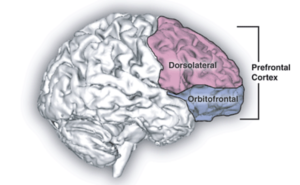An interesting study on the relation between “Type 2″ thinking and lucid dreaming… Hopefully, more studies relating to this field will follow…
LDF – Lucid Dream Frequency
CRT – Cognitive Reflections Test
DLPFC – Dorsolateral Prefrontal Cortex
Locus Of Control – “…the degree to which people believe that they have control over the outcome of events in their lives, as opposed to external forces beyond their control.” – Wikipedia
“Type 1 – thinking is fast, intuitive, unconscious thought. Most everyday activities (like driving, talking, cleaning, etc.) make heavy use of the type 1 system…
The type 2 system is slow, calculating, conscious thought. When you’re doing a difficult math problem or thinking carefully about a philosophical problem, you’re engaging the type 2 system. – Hacker News – quanticle on June 12, 2012 – https://news.ycombinator.com/item?id=4102848
The below excerpts are from a research paper initially published in the International Journal Of Dream Research – modified by addition of picture(s) – Rizea, A. E., & Malinowski, J. E. (2017). An investigation of a dual-processing hypothesis of lucid dreaming. International Journal of Dream Research, 10(1), 15–22. https://doi.org/10.11588/ijodr.2017.1.29722
“An Investigation Of A Dual-Processing Hypothesis Of Lucid Dreaming
Andreea E. Rizea, University of Bedfordshire, Department of Psychology, United Kingdom
Josie E. Malinowski, University of East London, School of Psychology, United Kingdom
 …Neuroimaging research has isolated the dorsolateral prefrontal cortex (DLPFC) as a brain structure associated with lucid dreaming, indicating that higher-order executive functions are involved in the onset of lucid dreaming. The DLPFC has also been implicated in the onset of type 2 thinking…
…Neuroimaging research has isolated the dorsolateral prefrontal cortex (DLPFC) as a brain structure associated with lucid dreaming, indicating that higher-order executive functions are involved in the onset of lucid dreaming. The DLPFC has also been implicated in the onset of type 2 thinking…
…The present study investigated this potential link, hypothesising that lucid dreaming frequency would be related to type 2 thinking…
… The type 2 processing mechanism is believed to be uniquely human as it allows sophisticated reasoning capacities different from those seen in animals…Furthermore, it is thought to require decontextualized processing which tends to reject knowledge or belief-based biases. When confronted with a problem, some people may come up with quick and plausible judgement, while others may discard the immediate response and engage in further reflection… One proposed explanation suggests that people tend to neglect information in their thinking, mostly because the type 1 processing mechanism is used by default due to its low computational expense…This strong bias to default to the least expensive computational mechanism results in humans being less than rational…The fMRI studies available provide support for the qualitative distinction between belief- and reason-based response, with activation in different regions of the brain for the two instances…In addition…found neuroimaging evidence of type 2 processing system overwriting the type 1 processing system that was coming from the emotion centres, thus concluding that the main area responsible for overwriting an emotional response is the dorsolateral prefrontal cortex….The sudden insight that one experiences at the beginning of a lucid dream could be attributed to the activation of the rational type 2 processing system that overwrites the dominant emotional type 1 system. The dorsolateral prefrontal cortex, which is normally deactivated during REM sleep…shows activation during lucid dreaming… The same area is thought to be involved mainly in linking the information stored in our short-term memory to the organisation of forthcoming actions… Thus, this particular area of the brain that activates during lucid dreams loads heavily on working memory while supporting theoretical thinking which is necessary for the planning of future events. These attributes have been found as defining features of the type 2 processing system. Moreover, the evolution of this rational second system can be seen as a precursor and requirement for the manifestation of lucid dreams because they require conscious rationality. There seem to be a connection between the workings of the second system and lucid dreaming mediated by the activity in the dorsolateral prefrontal cortex. Thus, it is worth investigating the dual-processing theory of reasoning as a possible explanation for the emergence of lucid dreams…
…A lateral/dorsolateral prefrontal cortex modulation caused by syllogism content was noticed in a study conducted by Brunetti et al (2014) when looking at the influence of emotions on reasoning abilities. This is the area that is deactivated during REM sleep, but active during lucid dreaming; thus providing more evidence of the connection between dual-processing theory and lucid dreaming, more precisely the activation of type 2 processing system that corresponds to the sudden realisation that one is dreaming. As far as causality is concerned, it makes sense to assume that the activation of type 2 processing system coincides with the onset of a lucid dream…
…Thus the first study supported previous research in finding a relationship between lucid dream frequency and dream recall frequency, and lucid dream frequency and internal locus of control. However, it did not support previous findings pertaining to openness to experience, nor video game play. Further, it did not find evidence for a relationship between lucid dream frequency and scores on the Cognitive Reflections Test, thereby not supporting a dual process hypothesis of lucid dreaming…
…Overall, the findings of the present paper indicate that there are relationships between prospective and retrospective measures of lucid dream frequency (LDF) and openness to experience, locus of control, and dream recall frequency. However, the dual processing hypothesis of lucid dreaming was not supported: no relationship between LDF and Cognitive Reflective Test scores, nor with scores on a syllogisms test, was found, neither with retrospective nor prospective estimates of LDF. In addition there was no relationship found between LDF and video game play…
…Further research could implement other measures of reflective reasoning abilities or focus on measuring reflective awareness of the environment and of oneself. On the other hand, this was not the first study to fail to find a relationship between lucid dreaming and a task known to require dorsolateral prefrontal cortex activation…
… It is likely that lucid dream onset is more complicated than a simple reactivation of the dorsolateral prefrontal cortex…it may be that different neural substrates are implicated in different kinds of lucid dreaming, since lucid dreaming is not a unitary phenomenon. Although humans spend one third of their life sleeping, most models of human cognition are structured based upon evidence derived from waking-life cognition. The development of a 24 hour model of cognition is necessary for the further understanding of consciousness. The existence of lucid dreaming reveals higher-order cognitive skills present during sleep; skills that previously have been assumed to be characteristic only of waking life. The question remains whether there is any relationship between the manifestation of higher-order cognitive skills in dreams and their manifestation in waking life. The uniquely human ability to reflect upon ourselves, think about past and plan the future could help illuminate the human condition…
…Conclusion There was no relationship found between rational reflective abilities measured with the Cognitive Reflective Test nor the syllogisms test and lucid dream frequency…therefore providing no evidence for a dual-processing account of lucid dreaming. However, internal locus of control, dream recall frequency, and openness to experience were correlated with lucid dream frequency, supporting previous research.”
Related Post(s):
Lucid Dreaming And Locus Of Control
Prefrontal Cortex and its Role in Lucid Dreaming
Neuroscience of Lucid Dreams and Amount of Frontopolar Cortex Grey Matter in Lucid Dreamers
